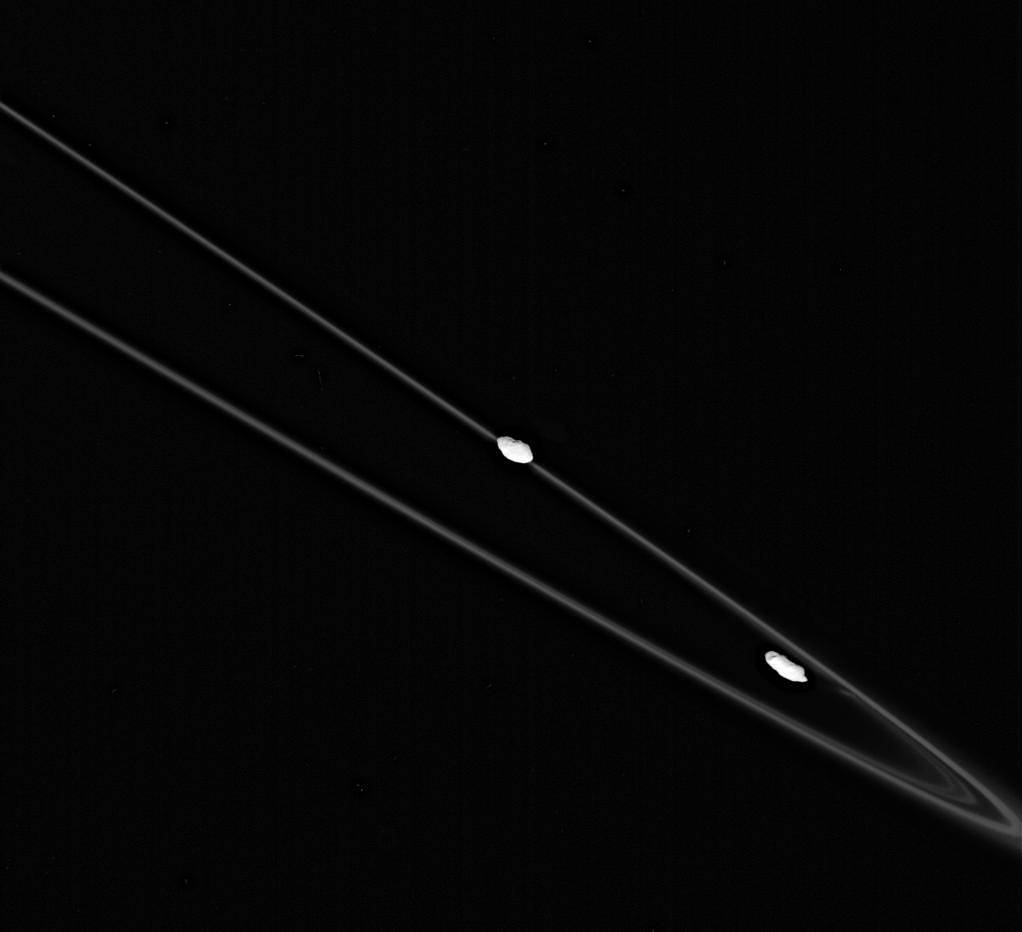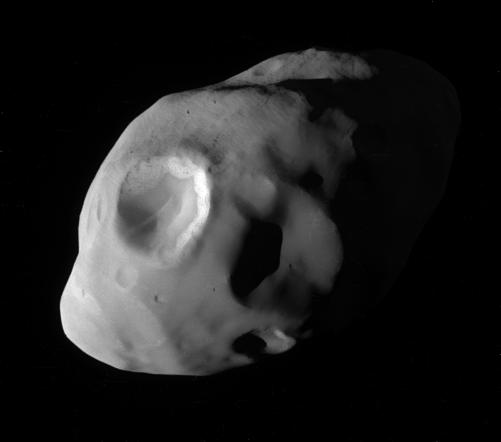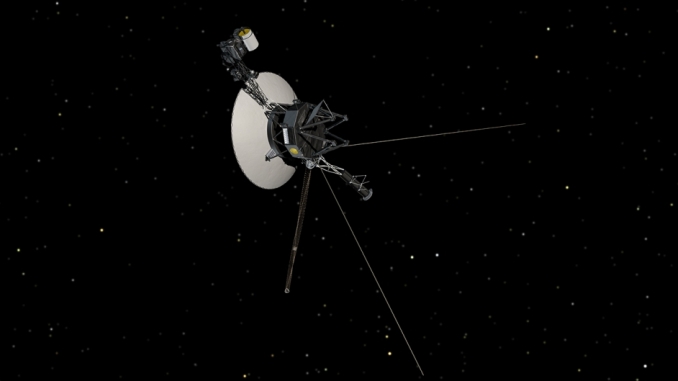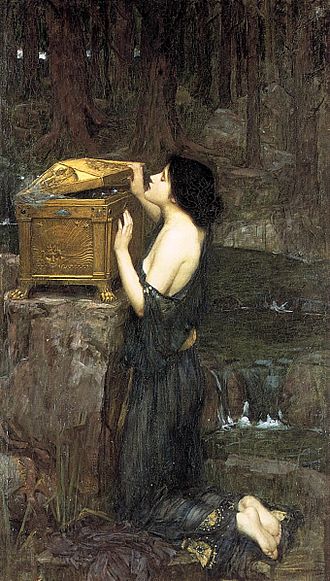What Is a Ring Shepherd Moon?
The planet Saturn holds its mighty rings in place with the support of its little helpers called shepherd moons. Ring shepherd moons, such as the Pandora moon act as the caretakers of a planet’s rings, just like a shepherd who takes care of his animals. The gravitational kicks that these moons give to loose ring particles keep them confined in the ring structure.

Each of the shepherding moons of Saturn has distinct features. Unlike the bigger moons, they have unusual shapes and are affecting the rings around them differently. They keep the ring of Saturn in order as they go round their orbit, some of them creating waves and streamers as they go.
The ring shepherds of Saturn are Pan, Daphnis, Atlas, Prometheus, and Pandora. Despite prior beliefs, recent studies indicate some of them may not play the same “shepherding” roles as previously thought.
A Ring Shepherds
The ring shepherds of the A ring are Pan and Daphnis. These two are embedded within the ring. Pan keeps the Encke Gap of the A ring clear while Daphnis functions in the smaller Keeler gap.
Just outside the A ring is the moon Atlas. Though it is named after a Titan with so much responsibility on his shoulders, the small moon did not inherit much of it. It was found out that it is not Atlas that keeps the edge of the A ring in shape but the co-orbitals Janus and Epimetheus.
F Ring Shepherds
Similarly, in Saturn’s F ring, it was long believed that the icy moons Prometheus and Pandora shepherd the ring from both sides. But recent findings indicate that only Prometheus has this effect on the ring.
Shepherd moons are not only found in Saturn but other planets and minor planets as well. Several inner moons of Jupiter, Uranus, and Neptune keep their rings well defined. The rings observed in the centaurs Chariklo and Chiron are believed to be shaped by shepherd moons too.

The Pandora Moon
Pandora Moon: Facts and Figures
All About the Name:
- Pronunciation – /pænˈdɔːrə/
- Behind the name – Pandōra (The first mortal human who released all evil into the world when she opened a box)
- Adjective/s – Pandoran
- Other designation – Saturn XVII
- Provisional designation – S/1980 S 26
Discovery Details
- Discoverer – S.A. Collins, D. Carlson, Voyager 1
- Discovery date – October 1980
Orbital Characteristics
- Parent Planet – Saturn
- Orbital period – 0.628504213 day/s
- Average Orbit Distance – 141,720 ± 10 km
- Mean Orbit Velocity – 58,985.8km/h
- Orbit Eccentricity – 0.0042
- Equatorial Inclination – 0.050°±0.004° to the equator of Saturn
Physical Features
- Dimensions – 104 × 81 × 64 km
- Equatorial radius – 40. 7± 1.5 km
- Equatorial circumference – 255.7 km
- Volume – 282,405 km3
- Mass – (1.371±0.019)×1017 kg
- Surface area – 20,816.07km2
- Mean density – 0.49±0.06 g/cm3
- Surface gravity – 0.0026–0.0060 m/s2
- Escape velocity – Approximately 0.019 km/s
- Rotation – Synchronous (tidally locked)
- Axial tilt – Zero
- Albedo – 0.6
- Temperature – Approximately 78 K
Pandora Moon
Saturn’s moon Pandora is a small irregular body, completing the planet’s set of 82 known natural satellites. It is one of the gas giant’s inner moons, orbiting it just outside the narrow F ring. It was discovered by the Voyager 1 team. Another designation for this moon is Saturn XVII.
Pandora is one of the residents of the F ring, the other one being the elongated moon Prometheus. The F ring is the narrowest of the major rings of Saturn. Prometheus orbits on the inner edge of this ring while Pandora is on the outer side.
Pandora is a small moon that looks like a potato. Its mean radius is 40.7 km. It is heavily cratered and actually has more craters than Prometheus. This moon is extremely covered with fine and icy material the size of dust.
Pandora and Prometheus are called ring shepherd moons because they confine Saturn’s F ring. Their gravitational influence “shepherds” the loose ring particles and keep them in place. New studies, however, challenge this belief. Scientists found out that Pandora has nothing to do with sculpting the F ring. The role solely rests in the hand of Prometheus on the inner edge.
In comparison, Pandora is 156.5 times smaller than Earth. It is also a bit smaller than Prometheus but nearly 11 times bigger than Daphnis. This cratered moon orbits Saturn at a distance of about 142,000 km. It takes 15 hours for Pandora to complete one trip around its parent planet.
Synchronous Rotation
Pandora is in a synchronous rotation with Saturn, just like the rest of the inner small moons and ring shepherds. Being in synchronous rotation means it takes Pandora the same time to rotate on its axis and revolve around Saturn. Due to this, the same side of the moon is towards the planet all the time. This phenomenon is called tidal locking. Our Moon also has the same relationship with our planet.
The orbit of Pandora is greatly affected by Prometheus’s nearby. Their orbits seem to be chaotic. Pandora is influenced by four 118:121 mean-motion resonances it has with Prometheus. Every 6.2 years, the closest distance (periapsis) of Pandora to Saturn aligns with the farthest distance (apoapsis) of Prometheus with the planet. Pandora is also in a 3:2 mean-motion resonance with the round moon Mimas.
What Does Pandora Look Like?

Pandora is irregularly shaped just like the other moons residing close to the rings. Its appearance can be easily compared to that of a potato, just like its F ring neighbor Prometheus. Another thing that differentiates Pandora from Prometheus is that it is heavily covered by fine particles of icy material.
Pandora is characterized by the presence of many craters. It has at least two large craters measuring 30 kilometers across. Aside from craters, the moon is also marked by some grooves and ridges, making its surface anything but smooth.
Unlike the other moons of Saturn whose craters are crisply outlined, Pandora’s are coated with icy debris. In fact, most of its craters look shallow since they are filled with the dust-sized particles that envelop the moon.
By looking at available data on its low density and high albedo, astronomers were able to infer that Pandora has an icy body that is very porous. Still, these are just assumptions as more about the moon is yet to be discovered.
Discovery

Pandora was discovered in October 1980. Behind it was the collaborative efforts of Stewart A. Collins, D. Carlson, and the rest of the Voyager 1 science team. The cratered moon was discovered just outside the F ring together with the inner moon Prometheus. The two satellites were observed in the images sent by the Voyager 1 spacecraft.
In late 2016, the Cassini spacecraft was able to snap a photo of Pandora during one of its closest flybys. The probe was about 40,000 km away from the moon during the encounter. The high-resolution image was taken using the spacecraft’s narrow-angle camera. With a quality of 240 meters per pixel, the surface of the cratered moon was seen closer than ever before.
Behind the Name
Before it was given its name, the moon Pandora was temporarily designated S/1980 S 26. In 1985, five years after its discovery, it was awarded the name of humankind’s first woman in Greek mythology.
The name Pandora (pan-DOR-uh) is from pān, which means “all,” and dōron, meaning “gift.”

Pandora was created by the god Hephaestus. Zeus instructed him to create a woman as a punishment for mankind receiving the stolen fire from Prometheus.
Each of the gods of Olympus gave presents to Pandora. Athena taught her the art of handicrafts while Hermes bestowed her the power of speech. She was also given a deceitful nature, among many others.
Zeus gave Pandora as a gift to Epimetheus and with her came a box (or a jar/ pithos) that contained all the evils in the world. Epimetheus accepted the gift, disobeying his brother Prometheus who previously warned him about receiving gifts from Zeus.
Curiosity overcame Pandora and she unknowingly opened the box, letting loose all the plagues and ills into the world. Seeing what she had done, Pandora tried to close the container, leaving the last creature inside which is “hope.”
In Science Fiction
Other than Greek myths, the name Pandora has appeared in works of science fiction.
There is also a moon named Pandora in the movie Avatar. What makes this moon extra special is that is it is habitable. It is home to a blue humanoid species called Na’vi. It orbits a gas giant planet called Polyphemus.
The fictional moon and planet are set in the triple star system of Alpha Centauri, specifically in Alpha Centauri A. This star system is our solar system’s closest neighbor.
Statistical Sources:
- https://en.wikipedia.org/wiki/Pandora_(moon)
- https://solarsystem.nasa.gov/moons/saturn-moons/pandora/by-the-numbers/
Image Sources:
- Ring shepherd moon (Prometheus and Pandora): https://www.nasa.gov/multimedia/imagegallery/image_feature_650.html
- Pandora moon: https://en.wikipedia.org/wiki/Pandora_(moon)
- Voyager 1: https://www.astronomytrek.com/10-interesting-facts-about-the-voyager-1-probe/
- Pandora in mythology: https://en.wikipedia.org/wiki/Pandora